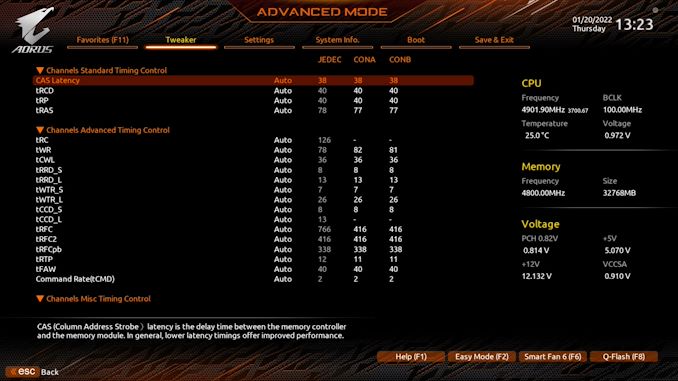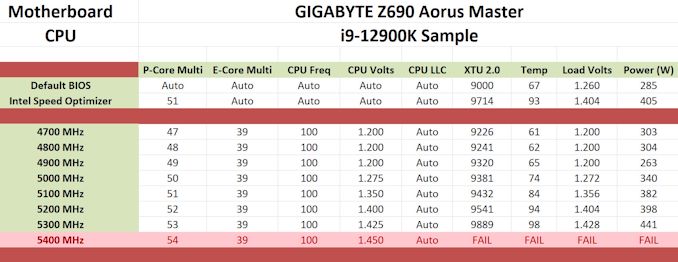The GIGABYTE Z690 Aorus Master Mobo Review: 10GbE Rounds Out A Premium Board
by Gavin Bonshor on February 25, 2022 9:00 AM ESTOverclocking
When it comes to overclocking on Intel's 12th generation processors, Alder Lake has a new yet important variable to consider. This is because not all of its cores are equal. Intel's latest Alder Lake processors feature a hybrid design with P-cores (performance) and E-cores (efficient). Focusing on the Core i9-12900K, it has 8 P-Cores, 8 E-cores, and 24 threads in total. While Hyperthreading isn't a new technology, the hybrid nature of Alder Lake combining two different types of CPU core is. The basic idea is that the P-cores do much of the front-loaded heavy lifting, the grunt work, so to speak, while the E-cores assist in the background with high-threaded workloads with a much lower overall power draw than the P-cores.
Having personally taken some time to investigate overclocking ability with the Core i9-12900K before diving into motherboard reviews, I found that the P-cores offer much more in terms of performance. In contrast, the E-cores don't have as much headroom or scalability as the P-cores. Fundamentally when paired with a Z690 motherboard, both the P-core and E-cores are unlocked. This gives two areas for users to consider when it comes to overclocking.
Another point of note when overclocking with Alder Lake, like with 11th gen and 10th gen, performance out of the box on both sets of cores are squeezed out via turbo, e.g., the P-Core Turbo on the Core i9-12900K is 5.2 GHz, while the E-Core turbo is 3.9 GHz. Make no mistake about it, Alder Lake is power-hungry, even more so from personal experience when overclocking than was the case with 11th gen Rocket Lake. This means adequate power being made available from a reliable and quality power supply is needed, as well as good quality and premium cooling such as AIOs, or even custom water cooling.
Experience with the GIGABYTE Z690 Aorus Master
When it comes to overclocking Intel's Alder Lake processors with the Z690 Aorus Master motherboard, GIGABYTE allows users to overclock the CPU, memory, and integrated graphics. There are extensive options available, with all of these being found within the Tweaker section of the firmware.
The Tweaker section has lots of options for users to customize, including multiple areas to overclock Alder Lake processors. This includes basic options for changing the multiplier on both the P-Cores and the E-Cores, with various offsetting options for heavier AVX workloads, and even options to adjust the base clock frequency and CPU Ring ratio.
It should be noted that on the Z690 Master, GIGABYTE is calling the E-cores ATOM CPU cores, which is technically what they are. There are also plenty of voltage and power options, including various voltages such as CPU VCore, VCCSA, base clock voltage, as well as multiple load-line calibration (LLC) profiles for the power delivery.
In terms of memory overclocking, GIGABYTE allows users to enable X.M.P 3.0 profiles on compatible memory kits, as well as manually set frequency, select between Intel's Gear profiles (2:1, 1:1, etc), as well as alter and set custom memory latencies. GIGABYTE's firmware actually has a large number of memory latencies for users to adjust, including primary, secondary, and tertiary latencies.
Overall GIGABYTE's Aorus firmware has all of the tools required for users to push Alder Lake to its limit and beyond. As previously mentioned, all of the overclocking settings can be found within the Tweaker section, and it has everything that users may or may not need.
Overclocking Methodology
Our overclocking methodology is as follows. We select the automatic overclock options and test for stability with the Intel XTU 2.0 benchmark and Prime95 to simulate high-end workloads. These stability tests aim to catch any immediate causes for memory or CPU errors.
For manual overclocks, based on the information gathered from the previous testing, start off at a nominal voltage and CPU multiplier, and the multiplier is increased until the stability tests are failed. The CPU voltage is increased gradually until the stability tests are passed. The process is repeated until the motherboard reduces the multiplier automatically (due to safety protocol) or the CPU temperature reaches a stupidly high level (105ºC+). Our testbed is not in a case, which should push overclocks higher with fresher (cooler) air.
Note: For the purposes of overclocking in our Z690 reviews, we will only be focusing on the P-cores (performance) as these simply scale better. The E-core (efficiency) will subsequently be set at 3.9 GHz throughout the entirety of our Z690 motherboard reviews.
Overclocking Results
Focusing on the overclocking performance when using our Core i9-12900K with the GIGABYTE Z690 Aorus Master, the biggest highlight throughout all of the testing was its tight VDroop control when using the fixed CPU V-Core setting within the firmware. This was the case as we tested each CPU frequency from 4.7 GHz to 5.3 GHz, with a small variation of between 0.03 and 0.06 V on the CPU VCore.
As we went up frequency stepping on the P-cores, we saw sequential increases in performance in the XTU 2.0 benchmark, even at our highest achievable all-core P-core overclock of 5.3 GHz at 1.425 V on the CPU VCore. This is our best overclock to date, and despite it being close to stable at 5.4 GHz at 1.450 V on the P-cores, the amount of heat generated would have made this impossible for us, even with a premium 360 mm AIO such as the ASUS ROG Ryujin II 360 that we are using.













35 Comments
View All Comments
Silver5urfer - Saturday, February 26, 2022 - link
You should have gone with MSI Unify X or ASUS APEX series for DRAM performance. Tachyon was not good for Z590 not sure how it is for Z690.meacupla - Friday, February 25, 2022 - link
Were you able to get memory to overclock beyond its stock 4800?The board's spec does say it supports up to 6400.
Because I have doubts that this board can really do 6400, when it has 4 slots.
Jp7188 - Sunday, February 27, 2022 - link
It would be great if Anandtech would do a piece comparing memory overclocks on the various boards. I was super excited to get my hands on a 6400 CL32 kit only to find it wouldn't work at full speed in the Aorus Master while it apparently does in other boards from ASUS and MSI. Fast mem with tight timings appears to be a significant differentiator for this generation of motherboards.Infy2 - Sunday, February 27, 2022 - link
Testing 2022 hardware with graphics card from 2016, time to upgrade I think? A powerful CPU like Adler Lake with such an obsolete graphics card will hardly show meaningful differences in gaming performance.shabby - Monday, February 28, 2022 - link
Insert AnandTech gpu review joke here...DanNeely - Monday, February 28, 2022 - link
The only way you're going to see any differences from CPU performance is to turn the graphics settings down to the point where the GPU isn't fully loaded and the CPU itself becomes the bottleneck. At that point any vaguely half decent card will work.Tom Sunday - Sunday, February 27, 2022 - link
Yes the GIGABYTE Z690 Aorus Master is pricey to say the least. I like to think being an enthusiast myself, but at the same time not convinced that l will be able to really taking proper advantage of all the Z690 Aorus Master offered premium features. It’s almost March/April now knocking on our door and I wonder with Intel breaking-out in the second half of 2022 their next-gen 13th Gen Core Raptor Lake, is it actually time to hold off building or even thinking now about an all new premium ($$$$) system? Intel proffers in featuring double-digit performance increases and greater core and thread counts. Moreover a more matured Alder Lake tech! Motherboard vendors in turn already doing a similar marketing dance of much improved MB-tech over their fall 2021 or early 2022 premium products. The old story prevails! “When to hold and when to fold with ones dollars?TLindgren - Monday, February 28, 2022 - link
Yeah, it's expensive but the real problem this motherboard have is that Gigabyte has a cheaper motherboard that is arguably better in many ways, the Z690 Aero D! The Master does have better integrated Audio though - the Aero D's ALC4080 is just as good as the Master's ALC1220 but they skimped on audio connectors so the Aero D is only 2.0, not 7.1.Differences:
* Aero D offers both x16/x0 or x8/x8 PCIe 5.0 vs the Masters x16 PCIe 5.0 plus PCIe 4.0 4x!. Both have a third x16 running in x4 PCI 3.0.
* Both have the same 10Gbps network chip, Aero D adds a 2.5Gbps to that.
* Aero D adds dual Thunderbolt (replaces the "plain" USB-C connectors)
* Aero D had DP+HDMI for the iGPU, Master has just DP - these outputs are useful for debugging and adding more screens while still rendering on the dGPU. With TB the Aero D has potentially four extra screens while Master has one!
* Audio is a clear win for the Master - the audio codec on the Aero D should be comparable to the one used on the Master, but it doesn't have ports in the back for more than 2.0 audio!
* Master has 5 M.2 compared to Aero D's 4.
* Master has 9 USB Type-A compared to Aero D's 6.
* Master has... "voltage measurement points". Swoon (not!).
I consider the extras the Aero D has to be far more consequential than the extras the Master has, *except* Audio.
The four PCIe 5.0 switches in the Aero D should cost Gigabyte more than the improved Audio on the Master and that ignores that Aero D also have 2xThunderbolt and a second LAN controller.
So, exactly why does the Master cost $499?
The answer is of course that retail pricing is controlled by what they think they can take for it, not what it costs to make, as long as they're not loosing money of course.
DanNeely - Monday, February 28, 2022 - link
With garbage 2.0 audio out the Areo D belongs in the $20 or less liquidation junkbin if not the dumpster out back.nevcairiel - Monday, February 28, 2022 - link
I haven't used analog audio connectors in years. Headphones run a USB DAC, desktop speakers are just stereo, and actual movie watching uses HDMI to a receiver.Gladly safe a whole bunch of money if audio is the only meaningful difference I don't care about. Not that I'm going to buy anything Gigabyte anyway..